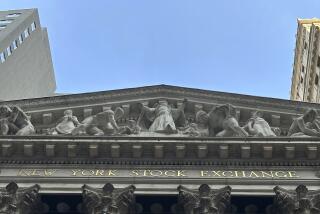Stock Market Barometers
- Share via
Fundamental and technical indicators of the market’s health
Key indexes vs. their 200-day moving averages:
A stock index’s 200-day moving average indicates the basic trend, up or down. It is generally bullish if the index stays above the average.
*
S&P; 500 (blue-chip stocks), Friday: 1,110.47
200-day moving average, Friday: 999.38
*
Russell 2,000 index (smaller stocks), Friday: 462:99
200-day moving average, Friday: 447.88
Price-to-earnings ratio of Standard & Poor’s 500: 24.46*
Based on operating earnings per share, 12 months ended Dec. 31
Average since 1923: 13.5
*
Dividend yield of the Standard & Poor’s 500: 1.44%
Average dividend yield of blue-chip stocks; avg. since 1923: 4.5%
*
Weekly new highs vs. new lows on the NYSE: 178/169
Data for the week ended Friday. More highs indicates a bullish trend.
*
Investment newsletter sentiment:
Stocks’ near-term trend as predicted by 135 independent investment newsletters, weekly survey by Investors Intelligence. The data are often viewed as a contrarian indicator: A rising percentage of bulls can signal a topping market.
May 15
Bullish: 45.5%
Bearish: 25.2
Correction: 29.3
*
Friday
Bullish: 47.5%
Bearish: 25.0
Correction: 27.5
*
Put-call ratio: 0.49
The ratio of stock put options to call options traded last week on the Chicago Board Options Exchange. A low put-call ratio--under 0.40--can be construed as bearish because it indicates a high level of optimism, leaving a lot of room for disappointment.
* Now calculated based on operating earnings, which exclude one-time charges--so P/E is lower than if actual earnings were used.
Source: A.G. Edwards & Sons. More information can be found at
https://www.agedwards.com on the World Wide Web.
More to Read
Inside the business of entertainment
The Wide Shot brings you news, analysis and insights on everything from streaming wars to production — and what it all means for the future.
You may occasionally receive promotional content from the Los Angeles Times.










